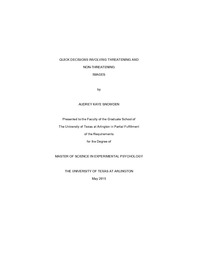
ATTENTION: The works hosted here are being migrated to a new repository that will consolidate resources, improve discoverability, and better show UTA's research impact on the global community. We will update authors as the migration progresses. Please see MavMatrix for more information.
Show simple item record
| dc.contributor.author | Snowden, Audrey Kaye | en_US |
| dc.date.accessioned | 2015-07-31T22:09:57Z | |
| dc.date.available | 2015-07-31T22:09:57Z | |
| dc.date.submitted | January 2015 | en_US |
| dc.identifier.other | DISS-13011 | en_US |
| dc.identifier.uri | http://hdl.handle.net/10106/24997 | |
| dc.description.abstract | The purpose of this research was to investigate the role of facial expressions with respect to quick decisions involving threatening and non-threatening images, to understand better the theoretical perspectives involving the amygdala, orbitofrontal cortex, and anterior cingulate cortex. Participants completed several surveys and played a categorization game where they viewed pictures for 1.25 seconds and then made a categorizing decision of "dangerous" or "safe" based on the presence of weapons in the photo. Participants had 1 second to decide. Pictures included men, women, and children, with either angry or neutral facial expressions, holding either weapons or innocuous items. Participant's reaction time was recorded. It was hypothesized that dangerous pictures would be categorized more quickly and accurately than safe and angry pictures more quickly and accurately than pictures with neutral expressions. It was also hypothesized that there would be an interaction between the categories. Main effects of object held (dangerous or safe) were found for both reaction times and accuracy rates. A main effect was found for facial expression with respect to accuracy rate. Interaction effects were also found for object held by facial expression with respect to both reaction times and accuracy rates. Analyses revealed that dangerous pictures were more accurately and quickly categorized than safe pictures and angry pictures were the least accurately categorized. These results provide some evidence that an actor-critic structure may exist. Furthermore, these results indicate that facial expressions influence the categorization of safe and dangerous situations. | en_US |
| dc.description.sponsorship | Levine, Daniel S. | en_US |
| dc.language.iso | en | en_US |
| dc.publisher | Psychology | en_US |
| dc.title | Quick Decisions Involving Threatening And Non-threatening Images | en_US |
| dc.type | M.S. | en_US |
| dc.contributor.committeeChair | Levine, Daniel S. | en_US |
| dc.degree.department | Psychology | en_US |
| dc.degree.discipline | Psychology | en_US |
| dc.degree.grantor | University of Texas at Arlington | en_US |
| dc.degree.level | masters | en_US |
| dc.degree.name | M.S. | en_US |
Files in this item
- Name:
- Snowden_uta_2502M_13011.pdf
- Size:
- 2.955Mb
- Format:
- PDF
This item appears in the following Collection(s)
Show simple item record


